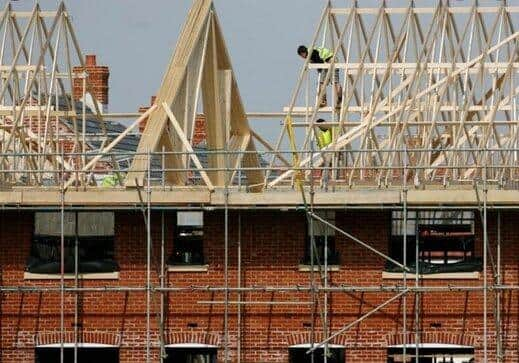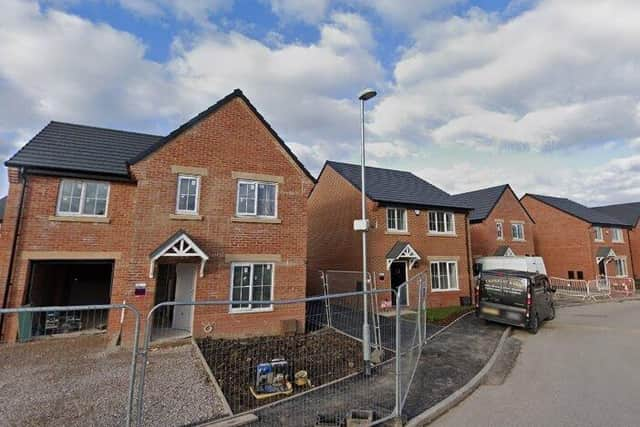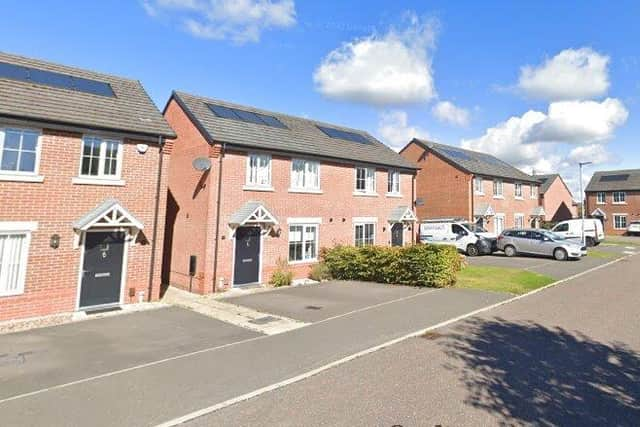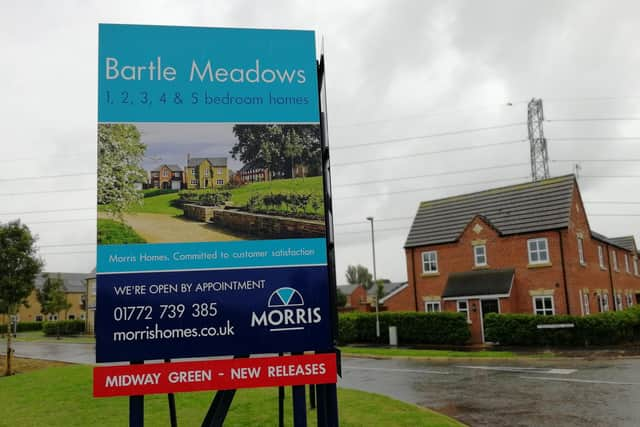Preston's affordable housing crisis: thousands can't afford open market rents or property prices - but the number of 'affordable home' alternatives is hundreds short each year
and live on Freeview channel 276
The estimate comes in an assessment of the city’s housing requirements, which also calculates that almost 400 more affordable homes would have to be created in Preston each year in order to meet the demand from people whose accommodation needs cannot be fulfilled by the market.
The shortfall comes in spite of a seven-fold surge in the number of dwellings categorised as affordable that have been built in the city in recent years.
Advertisement
Hide AdAdvertisement
Hide AdThe cabinet member responsible for planning at Preston City Council has told the Lancashire Post that it will take a radical rethink of national housing policy if the gap between supply and demand is ever to be bridged.


Between 2017 and 2022, an average of 220 affordable properties were constructed each year in the city – which is in itself a huge increase on the levels seen during the early 2010s. The average number delivered between 2010 and 2014 was just 31.
However, according to Preston’s most recent Housing Need and Assessment (HNDA) a further 395 affordable homes are required annually – while a total of 6,707 households cannot afford property prices or rents in the city’s “lowest quartile”, or cheapest quarter.
In order to be classed as ‘affordable’, a dwelling must usually be available for rent or sale at at least 20 percent off local market rates. The category also includes shared ownership and rent-to-buy schemes and is intended for those who cannot afford market prices in their area.
Advertisement
Hide AdAdvertisement
Hide AdMuch of the recent rise in affordable delivery in Preston is down to the boom in the total number of homes that have been built in the city over the same period. That is because Central Lancashire planning policy attempts to secure a fixed proportion of affordable housing on all new-build developments – 30 percent of the overall number of properties on estates in urban areas and 35 percent in rural parts.


However, David Borrow, planning and regulation cabinet member at the town hall, says that it is also born out of the authority’s efforts “to encourage” affordable home delivery.
“You’ve got to engage with [developers] and make [them] feel that this is what we want – and that is a strategy that is beginning to work,” he told the Post.
Cllr Borrow said that the success was reflected in a growth in proposals for developments in Preston made up entirely of affordable properties.
Advertisement
Hide AdAdvertisement
Hide AdHowever, he warned that the predicted shortfall could probably only be eradicated if the government “makes more funds available for social housing”.


Social rent – available to those meeting certain income criteria and who can demonstrate a connection to a particular area – is lower than its affordable counterpart and is calculated according to a formula based on property values and local earnings. The government said in February this year that social rent would be made a priority within its £11.5bn Affordable Homes Programme for 2021-2026.
Preston’s HNDA report reveals a burgeoning of the private rented sector in the city, with the proportion of households renting from private landlords having increased from 11 percent in 2001 to around 20 percent by 2018, according to Office for National Statistics estimates.
The study notes that whilst some of those turning to the sector in Preston are doing so as an “active choice”, for others it is the only option to meet their housing needs – and will include “frustrated would-be homeowners” who cannot afford increasing house prices.
Advertisement
Hide AdAdvertisement
Hide AdCllr Borrow says that the last time home ownership was out of reach for so many was the best part of a century ago, before the Second World War.


“That wasn’t the situation for my generation or my parents’ generation – so you have to go back a long way to [get to] a time when it was difficult for people who were in what they thought were okay jobs to be able to save enough money to get on the housing ladder in an area like Preston, which is not the most expensive in the country.
“My grandparents bought their first house when they got married at the age of 21 and he was employed as a painter and decorator. That was considered the norm then, but now people in their 30s are still struggling [to buy a home].”
Against that backdrop, Cllr Borrow said, better regulation of the private rented sector to ensure decent standards was also vital.
Advertisement
Hide AdAdvertisement
Hide AdIn spite of the scale of the affordable housing shortfall in Preston, national planning guidance means that “not all of this identified need is expected to be met or indeed is often possible to be met”, according to the city’s HNDA.
The reason for that concession is that the affordable housing quotas set by local authorities like the city council are dependent on whether they would affect the financial viability of proposed developments if they were enforced.
That means that developers can make a case for not having to adhere to the requirements as part of their planning applications, if doing so would push their profit margins below the 15-20 percent level that national planning policy deems that they should be able to expect to make.


While such viability claims are subject to independent assessments undertaken on behalf of the local authority, they can lead to housebuilders being able to deliver fewer affordable properties than would otherwise be required – or even none at all.
Advertisement
Hide AdAdvertisement
Hide AdThat has been the case on several recently-approved developments in Preston – often to the chagrin of the council’s planning committee.
Nevertheless, the HNDA – which was produced in December last year and will inform the drafting of the forthcoming Central Lancashire Local Plan, which will dictate development for the next 15 years – does state that the “imbalance” in affordable housing in the city “justifies the need for a robust affordable housing policy”.
It also recommends using that policy to “maximise delivery” delivery of affordable dwellings – especially homes for social rent.
The assessment suggests the need for an overall affordable tenure split of 88 percent social or affordable rented properties to 12 percent affordable home ownership.
Advertisement
Hide AdAdvertisement
Hide AdHowever, if “First Homes” – which are discounted to at least 30 percent less than market values – are factored in, the recommended affordable split changes to 68 percent rented to 32 percent ownership.
‘NOT REALLY AFFORDABLE’
Affordable housing may be anything but for many people, according to a group set up to investigate the issue.
In a report published in 2020, the Affordable Housing Commission found that a household earning the National Living Wage and living in social housing was paying around 25 percent of its income on rent – but the proportion of pay swallowed up on housing costs rose to more than 40 percent for those in an affordable rented home.
The commission recommended ending the “affordable” category altogether and said that, where financially viable, social landlords who have built and converted homes for affordable rent should aim to move them to social rent status when current tenancies end.
Advertisement
Hide AdAdvertisement
Hide AdIt also called on the government “to rebalance the housing system so there are affordable housing opportunities for all by 2045”.
A separate Housing, Communities and Local Government Select Committee report from the same year concluded that rents are only genuinely affordable when they do not exceed one third of a household’s income.
In response to that report, the government said that it “does not prescribe a definition of affordability, [as] it is a complex and ever-changing picture that is better understood and monitored at a local level”.
It added: “However, we recognise that the fundamental purpose of social housing is to provide affordable, safe and secure homes to those who cannot afford to rent or buy through the open market.
Advertisement
Hide AdAdvertisement
Hide Ad“The government continues to invest to deliver different types of rented social housing to meet the needs of a wide range of households including those at risk of homelessness in areas of the country where affordability is most pressured.
“By providing routes to develop social rented housing through both grant funding and the planning system, we aim to develop more social housing across the country. The increased costs of providing social housing in higher cost areas will always limit the types of property that will be available.”
In February this year, government agency Homes England announced that grant funding provided through the Affordable Homes Programme could now be used to fund replacement homes, alongside new affordable homes, as part of wider plans to “turbo boost” estate regeneration.
The aim is to replace housing that is outdated and no longer fit-for-purpose “with a larger number of high-quality, energy efficient new affordable homes”, it said.
PRESTON’S CHEAPEST PROPERTY PRICES
Advertisement
Hide AdAdvertisement
Hide AdThe lowest quartile property prices and monthly market rents in different parts of Preston in 2020:
Central – £68,000/£477
East – £94,250/£481
North – £145,000/£550
West – £100,000/£494
Rural East – £186,500/£550
Rural North – £208,000/£793
Source: Land Registry data via Preston Housing Need and Assessment 2022
WHAT DOES ‘AFFORDABLE’ MEAN?
The last national guidance on affordable prices and rents dates back to 2007 and was adopted in the latest Preston Housing Need and Assessment. It states that:
*** a household can be considered able to afford to buy a home if it costs up to 3.5 times that household’s gross income;
Advertisement
Hide AdAdvertisement
Hide Ad*** a household can be considered able to afford market renting where the rent payable is up to 25 percent of that household’s gross household income.
WHAT TYPE OF AFFORDABLE HOMES DOES PRESTON NEED?
According to housing sector contributors to Preston’s Preston Housing Need and Assessment, the city has:
***a specific need for bungalows, 1-bedroomed flats and 2, 3 and 4 bedroomed-houses;
***a need for adapted ground floor accommodation;
***a particular need for larger properties.
***a demand for shared ownership, but one that may be for properties that would not fall into the affordable bracket.
PRESTON AFFORDABLE HOUSING IN NUMBERS
Advertisement
Hide AdAdvertisement
Hide Ad12,220 – total number of affordable dwellings across Preston City Council area (2020)
10,209 – general needs rented units
1,496 – supported housing for older people units
515 – low-cost home ownership units.
33 percent – of Preston affordable dwellings are flats
24 percent – are 1 and 2-bedroomed houses
37 percent – are 3 or more-bedroomed houses
6 percent – are bungalows.
46 percent – were built since 1985
37 percent – were built between 1945 and 1984
16 percent – were built before 1945.
40 percent – of Preston affordable housing residents are single people
19 percent – are lone parents
35 percent – are couples with or without children
24 percent – are from an ethnic minority
48 percent – are not in work, a greater proportion than in other housing types
12 percent – are permanently sick or disabled
16 percent – are looking after the home or caring for someone
Advertisement
Hide AdAdvertisement
Hide Ad52 percent – of Preston affordable households have an income of less than £15,600 per year
Source: Preston Housing Need and Assessment 2022
Note: this article was amended on 3rd March, 2024, to correct a typographical error so that a sentence which read, “In order to be classed as ‘affordable’, a dwelling must usually be available for rent or sale at at least 20 percent of local market rates” was amended to read, as intended: “In order to be classed as ‘affordable’, a dwelling must usually be available for rent or sale at at least 20 percent off local market rates.”